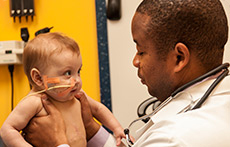Pulse Oximetry Screening of Newborns: Recommendations and Training Resources
In the fall of 2011, universal pulse oximetry screening of newborns was recommended by Secretary Kathleen Sebelius of the Department of Health and Human Services, the American Academy of Pediatrics, the American College of Cardiology and the American Heart Association.
The objective is to prevent morbidity and mortality associated with unrecognized critical congenital heart disease.
What does the guideline recommend?
The guideline recommends screening of all newborns in the well-baby or intermediate-care nursery between 24 and 48 hours of age, or as close as possible to discharge if the newborn is discharged prior to 24 hours of age. False positives increase when screening is performed before 24 hours of age or when the newborn is asleep.
How should failed screens be handled?
Failed screens should be resolved prior to discharge by echocardiography; discussion with a pediatric cardiologist prior to obtaining an echocardiogram is strongly recommended.
Seattle Children's Heart Center, Division of Neonatology and Neonatal Outreach Program have been working together to provide resources to hospitals and providers for training and for echocardiography in the event of failed screens. Providers should contact their regional pediatric cardiology resource for assistance in interpreting abnormal screens and facilitating echocardiography if necessary.
What is the sensitivity of the screen?
An estimated 1/500 to 1/1,000 newborns will fail the screen; 20% to 25% of those that fail will have critical congenital heart disease. The screen has a sensitivity of 60% to 75% for critical congenital heart disease, and thus a normal screen does not rule out heart disease.
What are the responsibilities of primary care providers?
Primary care providers who examine newborns prior to discharge will need to understand the screening algorithm in order to interpret results and respond appropriately to abnormal results. In addition, the guideline states that primary care providers should develop mechanisms to follow up on screening results at the first neonatal visit, and be able to provide screening to any newborn that missed being screened at birth.
Have screening protocols been implemented by hospitals?
Many hospitals in Washington state have already implemented a pulse oximetry screening program. Western Montana hospitals have been conducting screening for the past seven years under the guidance of Dr. Bruce Hardy, Montana pediatric cardiologist. Check with the newborn nursery staff at your local hospital for more information about your hospital's program.
Seattle Children's has developed a sample hospital form (PDF) for documenting pulse oximetry screening results, which can be downloaded and used by hospitals that are developing and implementing their screening protocols.
See also this online pulse oximeter tool.
Frequently Asked Questions about Implementing Pulse Oximetry Screening
Seattle Children's has anticipated questions from healthcare professionals and developed a page of FAQs to help with the "nuts and bolts" of performing pulse oximetry screening.
Where can I get more information?
Seattle Children's has developed a two-page quick reference guide for each region that includes the screening algorithm, tips on screening and numbers to contact a cardiologist 24/7.
- Seattle Children’s Hospital Campus Cardiology (PDF)
- Seattle Children’s South Sound Cardiology (PDF)
- Pediatric Cardiology of Alaska (PDF)
What training is available?
- Seattle Children's cardiologists are available to speak at Pediatric Grand Rounds or other educational conferences at your institution. For more information, please contact Dr. Amy Schultz, cardiologist.
